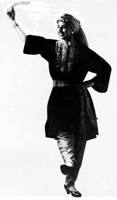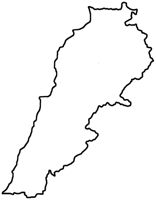
|
The Society of Folk Dance Historians (SFDH)
Lebanese Dances
[
Home |
About |
Encyclopedia | CLICK AN IMAGE TO ENLARGE |

|
Dabka, the national dance of Lebanon, has been well preserved not only in Lebanon but also by those Lebanese who have emigrated to Africa and the New World. The Dabka is a line dance par excellence, and is intimately related to the entire complex of line dances of Europe, both medieval and contemporary, and the northern tier of the Middle East, including Anatolia, the Levant1, the Caucasus, and Western Iran.
Two Dabkas were both performed at the International Festival in Baalbak, and also at the 1975 Smithsonian Institution's Festival of American Folklife in Washington, DC. Baalbakia, as the name implies, is a Dabka from Baalbek with many variations, performed widely throughout Lebanon and in emigrant colonies. The leader often improvises various intricate steps in the leading position. Leaders change often, with each person taking pleasure in Dabka music in 4/4 time. Shatta ya Dini is a Dabka especially arranged for that particular song and danced only to Shatta-ya Dini.
It should be mentioned that in addition for the Dabka, two other dance forms are found in Lebanon. The first is a weapon dance, performed with swords and shields by two men. It is called Raqs Es-Seif Wa Ters. Formerly a Pyrrhic (war dance), used to prepare young men in the use of weapons, it is now used in village celebrations such as weddings and funerals. The performers do this dance only with someone who is a life-long partner with whom they have learned the dance while young, usually a relative. The third type of dance, performed in party situations by both men and women, is an improvised solo dance. One might call this a domestic form by the misnomer – "belly dance." Often the best performers, especially males, will balance jars or other items on their heads.
INSTRUMENTS
Lebanese dancing is today accompanied by a wide variety of contemporary western instruments adapted to Lebanese style and Magam (scales), such as the violin, clarinet, trumpet, accordion, etc. Aside from these typical instruments of the greater Middle East, such as the 'Oud (lute), Qanun (or Kanun - zither), and Nay (end-blown flute) are found. In villages specifically local instruments such as the Munjaira (a type of flute) and a version of the Zurna (double reed) known as the Mizwiz are still played.
Generally speaking, the Lebanese abroad and urban Lebanese dance to recorded music of town orchestras, composed of violin(s), 'Oud, Qanun, Nay, Durbaki (goblet drums), and other western instruments. In the villages, any combination of instruments, usually played solo accompanied by a Darabuka (goblet drum) or other percussion instruments, can be heard.
Vocal music is often used widely for dance accompaniment.
COSTUMES
Costumes are typical 19th century village dress that are worn today by older people and members of the Druze sect, but still used for performing Dabkas in public. the Sharwal (loose-fitting cloth trousers) that are worn under the calf-length dresses, were used before World War I and are prevalent throughout the Middle East as costume remnants from Ottoman times. In Lebanon today, they may be seen in some villages worn mainly by men. Heavy-soled shoes are always worn in performing the Dabka to give a strong sound of stamping feet.
CUISINE
Lebanese cuisine uses a wide variety of vegetables prepared in various ways and eaten either hot or cold. The predominant meat is lamb or mutton. When meat is used, the dish is eaten hot; otherwise, an olive oil base is used with the vegetable and it is served cold or at room temperature. Yogurt is a staple, and accompanies most meals. One of the national dishes of Lebanon is Kibbe Naye, a mixture of fresh lamb meat, finely ground or pounded in a mortar, with grated onion, fine bulgar wheat, and spices. It is eaten raw with Arabic bread and usually served as an appetizer accompanied by Arak (Middle Eastern anisette). Appetizer dishes, called Maza in Arabic, are very popular in Lebanon, and it is not uncommon to be served a variety of fifty different dishes at one time to be accompanied by Araq (unsweetened distilled spirits).

1 The Levant is an approximate historical geographical term referring to a large area in the Eastern Mediterranean region of Western Asia. In its narrowest sense, it is equivalent to the historical region of Syria, which included present-day Syria, Lebanon, Jordan, Israel, Palestine, and most of Turkey southeast of the middle Euphrates. In its widest historical sense, the Levant included all of the Eastern Mediterranean with its islands, that is, it included all of the countries along the Eastern Mediterranean shores, extending from Greece to the eastern coastal region of Libya.
DOCUMENTS
- Lebanon, a country.
- Middle Eastern Drums, an article.
- Peoples of the North Caucasus, an article.
Used with permission of the author.
Printed in an AMAN Institute Syllabus.
This page © 2018 by Ron Houston.
Please do not copy any part of this page without including this copyright notice.
Please do not copy small portions out of context.
Please do not copy large portions without permission from Ron Houston.
